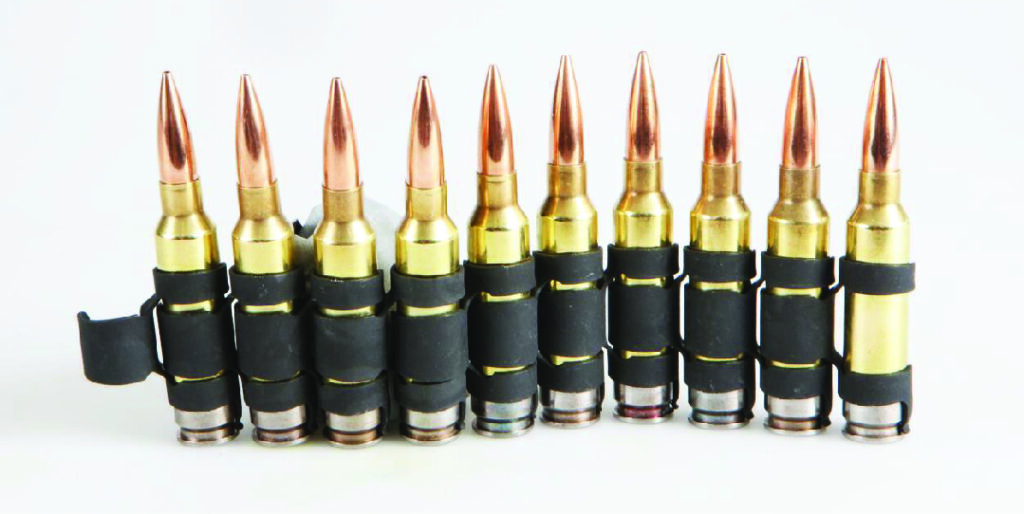Biting the Silver Bullet-19
By Sanjay Soni

The Widow Maker
The Soviet original military issue 7N6 cartridge variant introduced in 1974 is loaded with full metal jacket bullets that have a somewhat complex construction. The 3.43g (52.9gr) 25.55mm (1.01in) long boat-tail projectile’s jacket is clad in gilding metal (copper + steel + copper). The unhardened 1.43g (22.1gr) steel (steel 10) rod penetrator core is covered by a thin lead inlay which does not fill the entire point end, leaving a hollow cavity inside the nose. The bullet is cut to length during the manufacturing process to give the correct weight.

In the tip of the bullet there is a small air pocket that makes it tumble in a mere 2″ of flesh, but yet can punch a helmet at 300 meters with the hard steel core penetrator rated for 59 Rockwell hardness.
During the Soviet occupation of Afghanistan, the Afghans named the 5.45x39mm bullet “The Widow Maker” because it caused grievous wounds. This was primarily due to the tumbling and fragmenting effect of the bullet after entering soft tissue.
The Enhanced 7.62x39mm M43 cartridge has a similar construction of gilding metal with a mild steel insert enveloped by a lead core. However, it doesn’t have a hollow cavity at the nose. Therefore, it doesn’t have the yaw capability of the 5.45x39mm cartridge.
How a 10-gram cartridge, containing a 3.4-gram bullet 5.45mm in diameter could cause such drastic injury continues to intrigue people. That’s why they nicknamed it the “poison bullet”. It is one of the most lethal bullets in widespread military use.
By popular opinion, low-weight high-velocity intermediate calibers are considered more lethal than full-power rifle cartridges. The same can be said of high-velocity pistol cartridges like the 5.7x28mm and 5.45x18mm in comparison to larger slower calibers like the 9mm. This is because faster projectiles cause more local damage through hydro shock waves in addition to fragmentation and bullet yaw.
The 5.45x39mm and 5.56x45mm NATO are the most common rifle calibers of this class. There are debates as to the NATO round’s fragmentation rates and fragmenting distances but the expert consensus is that the Russian round is more lethal. If ranked by order of lethality, the 5.45mm would be classed with 12.7mm weapons.
It is specifically designed to tumble but contrary to wide belief, this does not mean that it is less reliant on velocity than the American 5.56x45mm or the Chinese 5.8x42mm. Velocity is still the deciding factor.
Another popular misconception is that the bullet shifts center of gravity. The bullet’s lateral center of gravity makes its tail heavy but the longitudinal center of gravity is at the center and it does not shift unless it hits hard armor.
The Gel test shows the terminal ballistics of the two calibers in ballistic gel. Simply by measuring the volume of the permanent cavity, the 5.45x39mm appears more lethal.
However, the test doesn’t appreciate the full lethality of the 5.45mm.
Ballistic gel simulates human muscle but not fat tissue and bones. It also fails to simulate damage to vital organs and blood vessels.

The 7N6 has a muzzle velocity of 920m/s and retains half of that or 450m/s at a distance of 650 meters. Within this range, the temporary cavity will likely be bigger than the above test because muscle tissue is elastic and will absorb the bullet’s energy. Fat tissue on the other hand will transfer more of the bullet’s energy in the form of hydro shockwave and rupture nearby organs and blood vessels. This is something that gel tests do not simulate very accurately.
Because of the 5.45mm bullet’s high initial velocity, low drag coefficient and high cross-sectional density, it retains energy better than other bullets of the same size and weight class.
Another factor is when the bullet hits the bone. Typically, the bone fragments into splinters and causes some local damage as with any other bullet. Because of the 5.45mm bullet’s length, it ‘steers’ the trajectory in a random yawing direction. This may increase the length of bullet travel and the chance of hitting bones. At a distance of 950 meters, the bullet slows down to 280m/s. However the tumbling characteristic works at almost any velocity.
Bullets designed to fragment have a cannelure grove at about the midsection which causes it to break into two. This promotes further fragmentation of the copper jacket and lead plug. The 5.56mm M885 has a lead plug in the rear, a steel penetrator less than half as big as the lead plug in the middle and an air pocket in the nose. The purpose of the lead in this design is to fragment when or if the cannelure breaks.
The 7N6 has a larger steel penetrator in the rear weighing 1.4 grams, a small amount of lead in the middle and a larger air pocket. It does not have cannelure, rather it is designed NOT to break into two. The purpose of the lead is not to fragment but, when hitting body armor, help the steel penetrator to push the nose jacket of the bullet away gracefully, and avoid blunting the impact of the penetrator. The Lead was removed and the penetrator lengthened in the 1996 7N10 ammunition.
Lessons in lethality
Any new weapon systems that an army wants will add to the loads that its troops are already carrying on the battlefield and has to be given careful consideration, Tim Fish reports.
Efforts to improve the firepower of dismounted infantry units in the past have been slow and incremental, with the ability of individual soldiers to carry heavy equipment for long durations being the primary limiting factor.
Soldier modernization programs have rarely delivered the kinds of steep changes in capability that have been touted. Plans for futuristic systems have often entailed too much risk or cost to develop, leading to the curtailment and scaling back of many of these initiatives. However, combat experience gained by NATO troops in Afghanistan and the arrival of the so-called era of Great Power Competition means there is a renewed urgency to try and increase the offensive power of the infantry.
Mike McCarthy, deputy director of the Close Combat Lethality Task Force (CCLTF) in the US Office of the Secretary of Defense said that in the history of close combat formations, dismounted squads “make up about 4% of a total force but they experience about 90% of the casualties and there hasn’t been breakthroughs in the way we can make them more lethal, more effective, more protected, more resilient”.
Outranged and outgunned
The challenges of weight remain but the demand to adopt more lethal weapons is increasing. The Russo-Ukraine War since March 2022 and the Nagorno-Karabakh conflict between Azerbaijan and Armenia in September-November 2020 have seen the use of drones and loitering munitions by frontline infantry units to extend the range of their targeting and attack capability. In Ukraine, the use of Anti-Tank Guided Missiles (ATGMs) has been well publicized as one of the important weapons used by the Ukrainian Armed Forces to blunt the initial attack by the Russian Federation Armed Forces.
Earlier in Afghanistan, NATO infantry units often found themselves outgunned by opponents using longer-range rifles and weapons of a higher caliber. US Army reports found that standard NATO rifles using 5.56mm lacked the range and impact to respond, leaving only those squad members with the larger 7.65mm support weapons able to engage. It means significant questions are being raised about how new weapons and equipment can be afforded to the infantry without increasing their load excessively.
McCarthy said that it’s more than just doing a lot of physical training, “it’s diet, management of their physical strength and looking for lighter weight gear – soldiers carry a heavy load so how do we make it lighter?”
US Army plans lethality upgrade.
In an attempt to increase soldier lethality and gain battlefield overmatch against GPC peer and near-peer adversaries, the US Army has decided to adopt new 6.8mm ammunition. Its Next Generation Squad Weapon (NGSW) project will partially replace the M4 and M249 weapons firing 5.56mm rounds. In April 2022 the Program Executive Office Soldier procurement team selected a solution from Sig Sauer that provides the SIG 6.8x51mm FURY hybrid brass and steel rounds along with the XM5 rifle and XM250 light machine gun.

Development of the 6.8×51 Cartridge
Traditional cartridge case materials have been discarded and a new approach adopted. The 6.8×51 SIG features a conventional brass upper case body with a steel alloy bottom and case-head section – hence the name hybrid ammunition. The hybrid design allows the ammo to fly at significantly higher pressures than conventional ammunition. Another benefit of the SIG hybrid case technology is that the case is 20 percent lighter for a loaded cartridge than a standard brass-cased cartridge.
With a factory-produced cartridge loaded to 80,000 psi, it was uncharted territory that wasn’t explored until now. To put that into perspective, A standard cartridge, like 308 Win, produces roughly 60,000 psi.
The chamber pressure of 80,000 psi enables a 135-grain (8.7g) projectile muzzle velocity of 3,000 feet per second (914m/s) from a 16-inch (406mm) barrel. SIG Sauer claims that the 6.8x51mm cartridge has performance superior to the 6.5mm Creedmoor, exhibiting 6 to 9 feet less bullet drop at 1,000 yards, all the while delivering 20–25% greater energy on target.
The ammunition can sustain pressures of 80k psi, which can push the round faster and further than the rounds almost three times as heavy as 5.56mm, which translates to more rounds carried per soldier.

However, McCarthy said that it is a “training issue” and soldiers have to be trained to fight using the weapon. Whilst the 6.8mm cartridge is heavier McCarthy said that it also “has greater knockdown power so you don’t need to carry as many of them. It’s a trade-off: fewer cartridges, more accuracy, better lethality. You can cut the weight by reducing the number of cartridges they have to carry.” He added: “Find your target, engage your target. Don’t just put a bunch of bullets out there and hope they will hit something”.
Sanjay Soni is the Managing Director of Hughes Precision Manufacturing Pvt. Ltd., India’s first small-caliber manufacturer in the private sector. An MBA from the Indian Institute of Management, Bangalore, he has been involved with the ammunition industry in India and abroad for the last 9 years.





